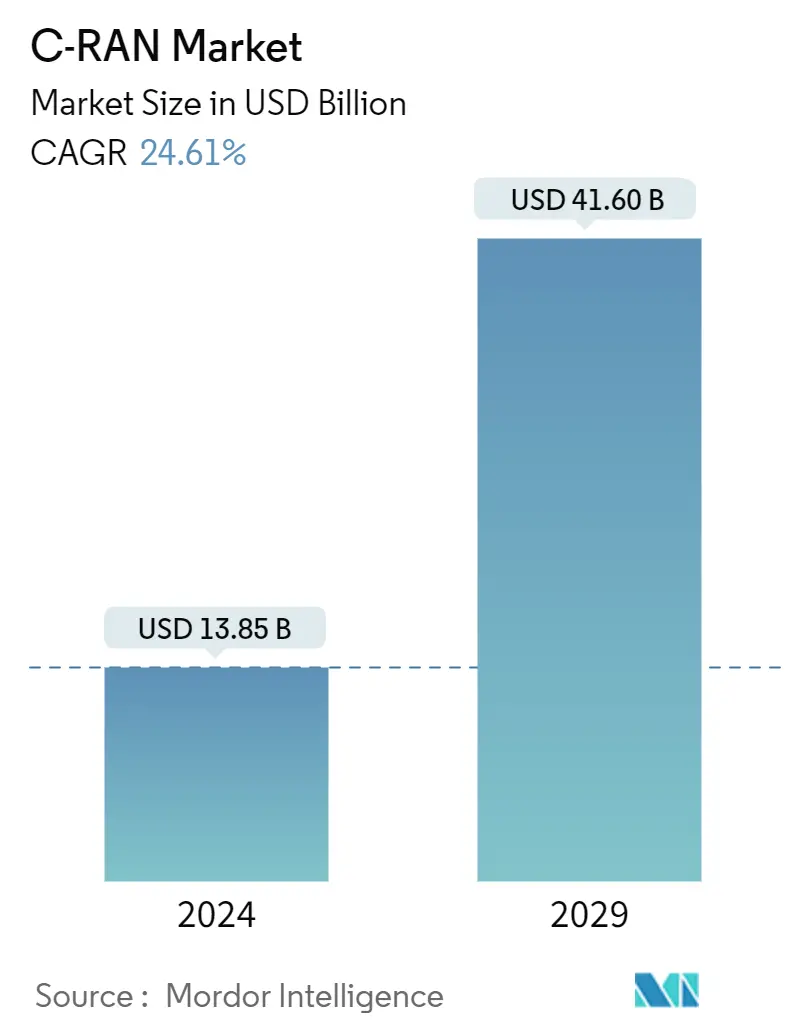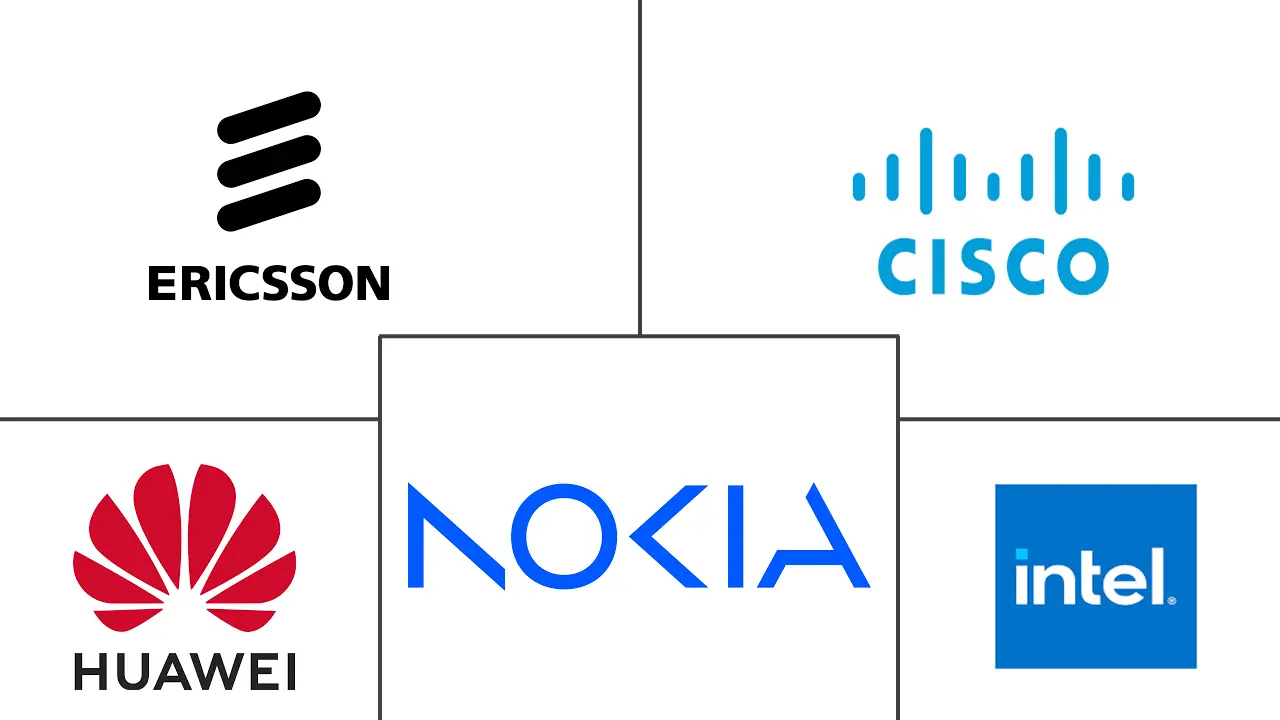Market Size of C-RAN Industry

| Study Period | 2019-2029 |
| Market Size (2024) | USD 13.85 Billion |
| Market Size (2029) | USD 41.60 Billion |
| CAGR (2024 - 2029) | 24.61 % |
| Fastest Growing Market | Asia Pacific |
| Largest Market | Asia Pacific |
Major Players
*Disclaimer: Major Players sorted in no particular order |
Cloud Radio Access Network Market Analysis
The C-RAN Market size is estimated at USD 13.85 billion in 2024, and is expected to reach USD 41.60 billion by 2029, growing at a CAGR of 24.61% during the forecast period (2024-2029).
The rapid increase in capital expenditure and reduction in operational spending is expected to drive the Cloud Radio Access Network Market over the forecasted years. Also, the increasing upgrade in wireless and telecommunication technology improves 4G and 5G accessibility, thereby imposing a positive outlook on market growth.
- The constant advancements in 5G technology also play a key role in driving the Cloud RAN market. 5G networks require increased capacity, low latency, and enhanced network performance, which align well with the abilities offered by C-RAN architecture. C-RAN enables the deployment of 5G networks with its centralized processing and progressive radio resource management, allowing operators to unlock the complete potential of 5G technology and provide a superior user experience.
- Furthermore, mobile operator RAN networks are expected to evolve significantly toward Cloud-based RAN solutions. In practice, most operators will adopt a hybrid strategy during the journey toward 6G simply because Cloud RAN will have to co-exist in the network with Classic RAN with a purpose-built baseband.
- The Internet of Things (IoT) is driving the development of connected devices across different sectors, such as smart cities, healthcare, agriculture, and manufacturing. To connect billions of IoT devices at once, 5G networks are being built, enabling massive connectivity. 5G networks are made more scalable and flexible by C-RAN architecture, which makes it likely to integrate IoT applications with them seamlessly. C-RAN provides dynamic resource provision to meet changing connectivity needs and rationalizes IoT traffic management by putting software-defined networking (SDN) ideas into practice and centralizing management operations.
- C-RAN can significantly decrease the cost of maintaining and deploying a wireless network. By consolidating the baseband processing purposes, C-RAN removes the requirement for dedicated hardware at each base station, decreasing the need for equipment. In addition, using software-defined networking (SDN) and virtualization technologies enables more efficient utilization of resources, further reducing costs.
- The demand for wireless communication is rising in a rapidly connected world. The need for a secure and fast wireless network has never been more critical, from smartphones to smart homes, from autonomous cars to Industrial Internet of Things devices. The challenge of spectrum scarcity, the limited number of radio frequencies that can be used to transmit mobile data, also increases with increasing demand for Internet connectivity.
Cloud Radio Access Network Industry Segmentation
The C-RAN market is defined based on the revenues generated from the solutions and services used in various network types across the globe. The analysis is based on the market insights captured through secondary research and the primaries. The market also covers the major factors impacting its growth in terms of drivers and restraints.
The cloud radio access network (C-RAN) market is segmented by components (solution, service [professional, managed], network type (5G, 4G, LTE, 3G (EDGE)) and geography (North America (United States, Canada), Europe (United Kingdom, Germany, Rest of Europe), Asia-Pacific (China, Japan, Rest of Asia-Pacific), Latin America, and Middle East and Africa)). The market sizes and forecasts regarding value (USD) for all the above segments are provided.
| By Components | ||||
| Solution | ||||
|
| By Network Type | |
| 5G | |
| 4G | |
| LTE | |
| 3G (EDGE) |
| By Geography | |||||
| |||||
| |||||
| |||||
| Latin America | |||||
| Middle East and Africa |
C-RAN Market Size Summary
The Cloud Radio Access Network (C-RAN) market is poised for significant expansion, driven by the increasing demand for advanced wireless communication technologies. The market is experiencing a transformative shift as operators transition towards cloud-based solutions to enhance network performance and reduce costs. C-RAN architecture, with its centralized processing and resource management capabilities, is instrumental in deploying 5G networks, offering the necessary scalability and flexibility to support the burgeoning Internet of Things (IoT) ecosystem. This evolution is further propelled by the need for high-speed connectivity and the integration of emerging technologies such as autonomous vehicles and augmented reality. The market's growth is supported by strategic collaborations and technological advancements, with key players like Cisco, Nokia, Huawei, Ericsson, and Intel leading the charge.
Geographically, North America holds a substantial share of the C-RAN market, benefiting from widespread 5G adoption and the region's focus on innovation and efficiency in telecommunications. The market in China is also thriving, with major players like Huawei and ZTE driving the deployment of 5G networks and C-RAN technology to support diverse applications across various sectors. In the Asia-Pacific region, countries such as India, South Korea, and Malaysia are embracing C-RAN architectures to meet growing customer demands. The competitive landscape is characterized by high rivalry and strategic partnerships, as evidenced by recent collaborations between Nokia and Elisa, and Ericsson and Google, which aim to enhance the capabilities and performance of Cloud RAN solutions. These developments underscore the market's dynamic nature and its potential for continued growth in the coming years.
C-RAN Market Size - Table of Contents
-
1. MARKET INSIGHTS
-
1.1 Market Overview
-
1.2 Introduction to Market Drivers and Restraints
-
1.3 Market Drivers
-
1.3.1 Rising Demand of 5G Trend Across Various End-user Segment
-
1.3.2 Need to Eliminate the Cost of Hardware Equipment Used in 4G-5G Network
-
-
1.4 Market Restraints
-
1.4.1 Scarce Spectrum Availability for Network Expansion When Combined With Regulatory Limits
-
-
1.5 Industry Attractiveness - Porter's Five Forces Analysis
-
1.5.1 Threat of New Entrants
-
1.5.2 Bargaining Power of Buyers/Consumers
-
1.5.3 Bargaining Power of Suppliers
-
1.5.4 Threat of Substitute Products
-
1.5.5 Intensity of Competitive Rivalry
-
-
1.6 Technology Snapshot
-
1.6.1 Cloud-Virtualization
-
1.6.2 Centralized-RAN
-
-
-
2. MARKET SEGMENTATION
-
2.1 By Components
-
2.1.1 Solution
-
2.1.2 Services
-
2.1.2.1 Professional
-
2.1.2.2 Managed
-
-
-
2.2 By Network Type
-
2.2.1 5G
-
2.2.2 4G
-
2.2.3 LTE
-
2.2.4 3G (EDGE)
-
-
2.3 By Geography
-
2.3.1 North America
-
2.3.1.1 United States
-
2.3.1.2 Canada
-
-
2.3.2 Europe
-
2.3.2.1 United Kingdom
-
2.3.2.2 Germany
-
2.3.2.3 Rest of Europe
-
-
2.3.3 Asia-Pacific
-
2.3.3.1 China
-
2.3.3.2 Japan
-
2.3.3.3 Rest of Asia-Pacific
-
-
2.3.4 Latin America
-
2.3.5 Middle East and Africa
-
-
C-RAN Market Size FAQs
How big is the C-RAN Market?
The C-RAN Market size is expected to reach USD 13.85 billion in 2024 and grow at a CAGR of 24.61% to reach USD 41.60 billion by 2029.
What is the current C-RAN Market size?
In 2024, the C-RAN Market size is expected to reach USD 13.85 billion.

